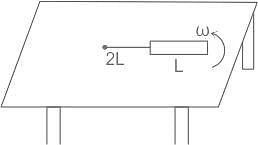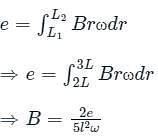Test: Electromotive Force - EmSAT Achieve MCQ
10 Questions MCQ Test - Test: Electromotive Force
Consider the following statement for a circular conductor moving in and out of the magnetic field:
- The polarity of induced motional EMF is such that it supports the change in magnetic flux responsible for its production.
- Magnetic flux is independent of the area of the circular conductor.
- If the coil is cut somewhere and then moved in and out of the magnetic field, EMF will be generated.
- The basic cause of induced emf is the change in magnetic flux.
Which of the following statements are correct
A metal wheel with 20 metallic spokes each 1m long, is rotated with a speed of 180 rpm, in a plane perpendicular to the earth's field. at that place. If the magnitude of the field is 0.40 gauss, then the emf between the axle and rim of the wheel is
| 1 Crore+ students have signed up on EduRev. Have you? Download the App |
A metallic rod of length l is tied to a string of length 2l and made to rotate with angular speed ω on horizontal table with one end of the string fixed. If the induced emf across the ends of the rod is e, then the vertical magnetic field in the region is.


A wire of length 3m is moving with a speed of 50m/s in a direction perpendicular to a magnetic field of 4.5 Wb/m2. The induced emf in the wire is
If an accelerating magnet is moved inside a current-carrying coil, then what will happen to the current inside it?
Which among the following rules is used to determine the direction of induced emf?
What is the relation between the direction of motion of the conductor and the direction of induced emf?
A metal wheel with 20 metallic spokes each 1m long, is rotated with a speed of 180 rpm, in a plane perpendicular to the earth's field. at that place. If the magnitude of the field is 0.40 gauss, then the emf between the axle and rim of the wheel is
A circular ring containing n number of spokes, parallel to each other, is rotated in a plane that is perpendicular to the earth's magnetic field. This generates EMF between the center and circular rim. If we increase the number of spokes of the ring then the induce emf























